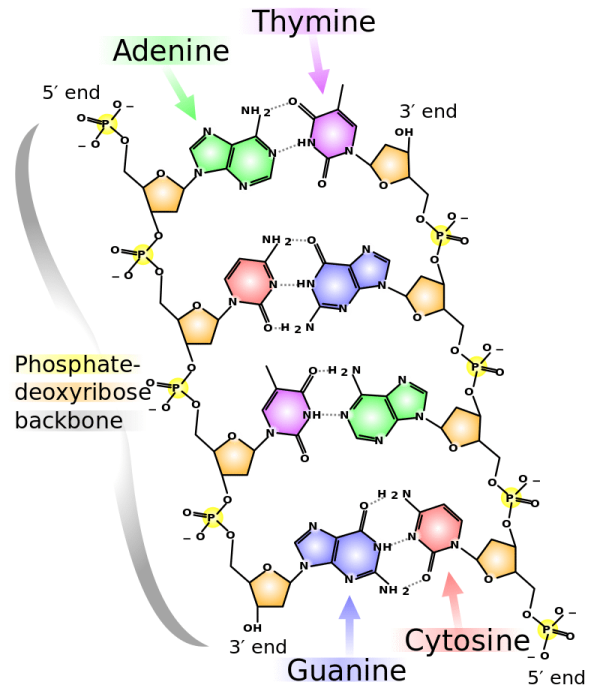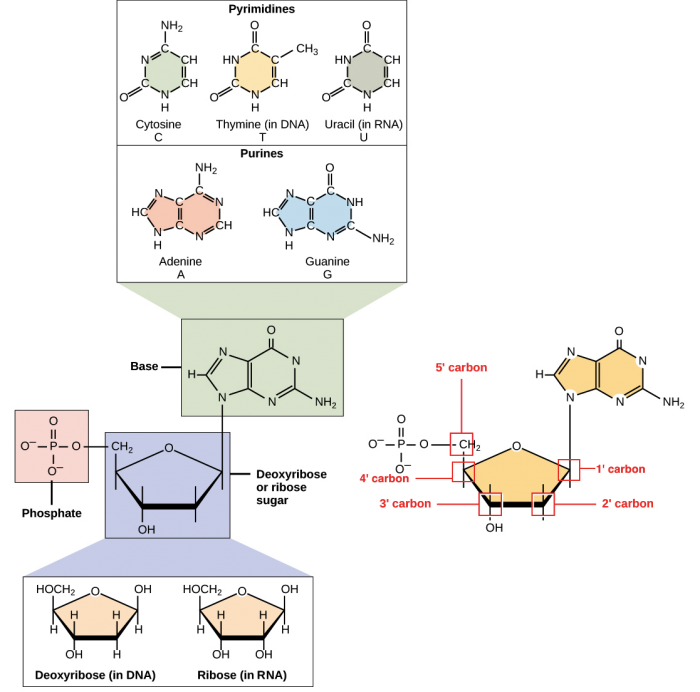
The Elements of Nucleic acids function as the blueprints for life, able to hold the genetic information that will be translated into proteins. The nucleic acids are made out of five primary elements: phosphorus, nitrogen, oxygen, carbon, and hydrogen.
How do these elements link together to create the nucleic acids and what functions do they have?
What Are The Nucleic Acids?
The nucleic acids are macromolecules that contain the hereditary information necessary for life. They are passed down from parent to child, and they code for the proteins needed to create functioning organisms, tissues, and cells. There are two different kinds of nucleic acid: ribonucleic acid (RNA) and deoxyribonucleic acid (DNA). DNA is the form of nucleic acid common to all living things; all plants, animals, and even single-celled bacteria have DNA. RNA is used as the primary method of storing genetic material in some viruses, but scientists don’t usually consider these viruses to be alive.
“All of today’s DNA, strung through all the cells of the earth, is simply an extension and elaboration of [the] first molecule.” — Lewis Thomas
The DNA of a cell is located inside the cell’s nucleus, and in some other types of organelles like the mitochondria of a cell. (This is true for eukaryotes, but prokaryotes have DNA which isn’t encased in a membrane like a nucleus is). The DNA is divided into long chunks called chromosomes, and every chromosome, in turn, contains thousands of genes. Each of the genes holds specific instructions for how to create the proteins the cell needs.
The creation of proteins is where RNA comes into play. There are multiple kinds of RNA: messenger RNA (mRNA), ribosomal RNA (rRNA), and transfer RNA (tRNA). The messenger RNA’s job is to form a copy of the DNA chain, to create a transcript of it. The mRNA does this by reading the molecular chains of DNA and forming into a copy of the DNA sequence. The tRNA is responsible for transferring amino acids to the ribosomes so that proteins may be synthesized, while the rRNA helps create the ribosomes themselves.
What Are Nucleotides And Nitrogenous Bases?

Photo: By Madprime (talk · contribs) – Own workiThe source code of this SVG is valid.This vector image was created with Inkscape., CC BY-SA 3.0, https://commons.wikimedia.org/w/index.php?curid=1848174
Both DNA and RNA are polymers, meaning they are complex molecules made out of simpler monomers. The complex polymers that DNA forms are referred to as nucleotides and the combination of nucleotides creates polynucleotides. Every nucleotide has the same structure: a five-carbon sugar, one phosphate group, and a nitrogen-ring structure referred to as the nitrogenous base. The sugar molecule is in the center of the nucleotide while the carbons and phosphate groups are attached to its points.
“Trying to read our DNA is like trying to understand software code – with only 90% of the code riddled with errors. It’s very difficult in that case to understand and predict what that software code is going to do.” — Elon Musk
The nitrogenous bases of the nucleotides are carbon-based molecules in ring structures. There are four nitrogenous bases that make up the DNA structure: adenine, thymine, guanine, and cytosine. These are abbreviated as A, T, G, and C respectively. Both guanine and adenine are referred to as purines, which means that their structures have two carbon-nitrogen rings that are fused together. In contrast, thymine and cytosine are called pyrimidines and both have one nitrogen-carbon ring.

Photo: _Image modified from “Nucleic acids: Figure 1,” by OpenStax College, Biology (CC BY 3.0)._ via Khan Academy
Differences Between RNA And DNA
RNA is structured differently than DNA. RNA also has adenine, cytosine, and guanine like DNA does, but unlike DNA it doesn’t have thymine. RNA instead has a different pyrimidine base: uracil (U).
There are other differences between RNA and DNA as well. DNA and RNA have slightly different sugars in addition to different bases. The sugar in RNA is referred to as ribose, while the sugar in DNA is called deoxyribose. The two sugars have very similar structures, but they differ in an important way. The second carbon that is found within ribose has a hydroxyl group, while deoxyribose’s equivalent carbon has hydrogen there instead. The sugars are found within a central position in nucleotides while the bases are connected to the 1’ carbon position and the phosphate is attached to the 5’ carbon position.
The Phosphate Group
Nucleotides can have a single phosphate group or multiple phosphate groups. Nucleotides can have up to three phosphate groups connected to the carbon 5’ sugar. There is some dispute as to what counts as a nucleotide, as some sources only use the term nucleotide to refer to bases paired with a single-phosphate group. It’s important to remember that when RNA and DNA chains end up joining together they lose two phosphate groups, so if there is a chain of RNA or DNA molecules the nucleotides in them will only possess one phosphate group.
Now that we’ve looked at the structure of the nucleic acid molecule, we can discuss what molecules compose these structures.
How The Different Molecules Compose The Nucleic Acids
The five different molecules that comprise nucleic acids (carbon, nitrogen, hydrogen, oxygen, and phosphorus) each create specific parts of the DNA or RNA molecule.
Carbon molecules are an extremely important element of nucleotides. They compose the sugar found in the nucleic acid backbone of the molecules, and they also help create the nitrogenous bases of the nucleotide. Nitrogen molecules create both purines and pyrimidines, different types of amino acids. The amino acid groups have hydrogen bonds between them, and these bonds mean that the base pairs stay linked together in the strands of nucleic acid.
“DNA is the family history book you’ve been walking around with your whole life!” — Blaine T. Bettinger
Hydrogen molecules stay attached to the oxygen and carbon atoms that exist in between the nitrogenous bases and sugars of the nucleic acids. The hydrogen-nitrogen bonds of the nitrogenous bases are polar, and they let hydrogen bonds form between nucleic acid strands. This is how DNA gets its double-helix formation, as the two DNA strands are linked together by the hydrogen bonds found in the base pairs. There are also oxygen molecules found in the nucleotides. The atoms of oxygen are found in multiple parts of the nucleotide: the sugar, the nitrogenous bases, and the phosphates. RNA and DNA have different sugar structures. RNA has four hydroxyl (OH) groups while deoxyribose has pure hydrogen replacing one of the OH groups, hence the “deoxy” in DNA.
Phosphorus molecules make up the phosphate groups in the nucleotides. They are composed of both oxygen and phosphorus molecules. The existence of these phosphorus groups is important because they are what let the sugars of different nucleotides link together to form a polymer.









